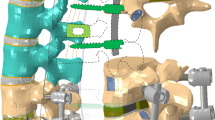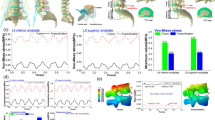Abstract
Topping-off technique has been proposed to prevent adjacent-segment degeneration/disease following spine fusion surgery. Nevertheless, few studies have investigated biomechanics of the fusion surgery with topping-off device under whole-body vibration (WBV). This biomechanical study aimed to investigate the vibration characteristics of human lumbar spine after topping-off surgery, and also to evaluate the effect of bony fusion on spine biomechanics. Based on a healthy finite-element model of lumbosacral spine (L1–sacrum), the models of topping-off surgery before and after bony fusion were developed. The simulated surgical procedures consisted of interbody fusion with rigid stabilizer at L4–L5 segment (rigid fusion) and dynamic stabilizer at degenerated L3–L4 segment. An interspinous implant, Device for Intervertebral Assisted Motion (DIAM, Medtronic Inc., Minnesota, USA), was used as the dynamic stabilizer. The stress responses of spine segments and implants under a vertical cyclic load were calculated and analyzed. The results showed that compared with rigid fusion alone, the topping-off technique significantly decreased disc stress at transition segment (L3–L4) as expected, and resulted in a slight increase in disc stress at its supra-adjacent segment (L2–L3). It indicated that the topping-off stabilization using DIAM might provide a good tradeoff between protection of transition segment and deterioration of its supra-adjacent segment during WBV. Also, it was found that bony fusion decreased stress in L4 inferior endplate and rigid stabilizer but had nearly no effect on stress in DIAM and L3–L4 disc, which was helpful to determine the biomechanical differences before and after bony fusion.
Graphical abstract








Similar content being viewed by others
References
Hashimoto K, Aizawa T, Kanno H, Itoi E (2019) Adjacent segment degeneration after fusion spinal surgery-a systematic review. Int Orthop 39(8):1459–1464
Xia XP, Chen HL, Cheng HB (2013) Prevalence of adjacent segment degeneration after spine surgery: a systematic review and meta-analysis. Spine 38(7):597–608
Park P, Garton HJ, Gala VC, Hoff JT, McGillicuddy JE (2004) Adjacent segment disease after lumbar or lumbosacral fusion: review of the literature. Spine 29(17):1938–1944
Akamaru T, Kawahara N, Tim Yoon S, Minamide A, Su Kim K, Tomita K et al (2003) Adjacent segment motion after a simulated lumbar fusion in different sagittal alignments: a biomechanical analysis. Spine 28(14):1560–1566
Ma JX, Jia HB, Ma XL, Xu WG, Yu JT, Feng R et al (2014) Evaluation of the stress distribution change at the adjacent facet joints after lumbar fusion surgery: a biomechanical study. Proc Inst Mech Eng H 228(7):665–673
Zhu ZQ, Liu CJ, Wang KF, Zhou J, Wang JF, Zhu Y et al (2015) Topping-off technique prevents aggravation of degeneration of adjacent segment fusion revealed by retrospective and finite element biomechanical analysis. J Orthop Surg Res 10:10
Cao LL, Liu YM, Mei W, Xu JG, Zhan S (2020) Biomechanical changes of degenerated adjacent segment and intact lumbar spine after lumbosacral topping-off surgery: a three-dimensional finite element analysis. BMC Musculoskelet Disord 21(1):104
Cabello J, Cavanilles-Walker JM, Iborra M, Ubierna MT, Covaro A, Roca J (2013) The protective role of dynamic stabilization on the adjacent disc to a rigid instrumented level. An in vitro biomechanical analysis. Arch Orthop Trauma Surg 133(4):443–448
Chen CS, Shih SL (2018) Biomechanical analysis of a new lumbar interspinous device with optimized topology. Med Biol Eng Comput 56(8):1333–1341
Chou PH, Lin HH, An HS, Liu KY, Su WR, Lin CL (2017) Could the topping-off technique be the preventive strategy against adjacent segment disease after pedicle screw-based fusion in lumbar degenerative diseases? A systematic review. Biomed Res Int 2017:4385620
Fan YP, Zhou SB, Xie T, Yu ZF, Han X, Zhu LL (2019) Topping-off surgery vs posterior lumbar interbody fusion for degenerative lumbar disease: a finite element analysis. J Orthop Surg Res 14(1):476
Wang W, Sun XY, Zhang TT, Sun SY, Kong C, Lu SB (2020) Topping-off technology versus posterior lumbar interbody fusion in the treatment of lumbar disc herniation: a meta-analysis. Biomed Res Int 2020:2953128
Wilke HJ, Drumm J, Häussler K, Mack C, Steudel WI, Kettler A (2008) Biomechanical effect of different lumbar interspinous implants on flexibility and intradiscal pressure. Eur Spine J 17(8):1049–1056
Lin HM, Liu CL, Pan YN, Huang CH, Shih SL, Wei SH et al (2014) Biomechanical analysis and design of a dynamic spinal fixator using topology optimization: a finite element analysis. Med Biol Eng Comput 52(5):499–508
Kong C, Lu SB, Hai Y (2015) Zang L Biomechanical effect of interspinous dynamic stabilization adjacent to single-level fusion on range of motion of the transition segment and the adjacent segment. Clin Biomech 30(4):355–359
Lee CH, Kim YE, Lee HJ, Kim DG, Kim CH (2017) Biomechanical effects of hybrid stabilization on the risk of proximal adjacent-segment degeneration following lumbar spinal fusion using an interspinous device or a pedicle screw-based dynamic fixator. J Neurosurg Spine 27(6):643–649
Xu M, Yang J, Lieberman I, Haddas R (2019) The effect of surgical alignment in adult scoliotic spines on axial cyclic vibration: a finite element study. J Comput Inf Sci Eng 19(2):UNSP 021006
Goel VK, Park H, Kong WZ (1994) Investigation of vibration characteristics of the ligamentous lumbar spine using the finite element approach. J Biomech Eng 116(4):377–383
Guo LX, Fan W (2018) Dynamic response of the lumbar spine to whole-body vibration under a compressive follower preload. Spine 43(3):E143–E153
Bovenzi M, Schust M, Mauro M (2017) An overview of low back pain and occupational exposures to whole-body vibration and mechanical shocks. Med Lav 108(6):419–433
Wade KR, Schollum ML, Robertson PA, Thambyah A, Broom ND (2016) ISSLS Prize Winner: Vibration really does disrupt the disc: a microanatomical investigation. Spine (Phila Pa 1976) 41(15):1185–1198
Rohlmann A, Hinz B, Bluthner R, Graichen F, Bergmann G (2010) Loads on a spinal implant measured in vivo during whole-body vibration. Eur Spine J 19(7):1129–1135
Fan W, Guo LX, Zhao D (2019) Stress analysis of the implants in transforaminal lumbar interbody fusion under static and vibration loadings: a comparison between pedicle screw fixation system with rigid and flexible rods. J Mater Sci Mater Med 30:118
Oikonomidis S, Ashqar G, Kaulhausen T, Herren C, Siewe J, Sobottke R (2018) Clinical experiences with a PEEK-based dynamic instrumentation device in lumbar spinal surgery: 2 years and no more. J Orthop Surg Res 13:196
Bredow J, Lohrer L, Oppermann J, Scheyerer MJ, Sobottke R, Eysel P et al (2017) Pathoanatomic risk factors for instability and adjacent segment disease in lumbar spine: how to use topping off? Biomed Res Int 2017:2964529
Fan W, Guo LX (2017) Influence of different frequencies of axial cyclic loading on time-domain vibration response of the lumbar spine: a finite element study. Comput Biol Med 86:75–81
Palepu V, Helgeson MD, Molyneaux-Francis M, Nagaraja S (2019) The effects of bone microstructure on subsidence risk for ALIF, LLIF, PLIF, and TLIF spine cages. J Biomech Eng 141(3):031002
Guo LX, Fan W (2017) The effect of single-level disc degeneration on dynamic response of the whole lumbar spine to vertical vibration. World Neurosurg 105:510–518
Más Y, Gracia L, Ibarz E, Gabarre S, Peña D, Herrera A (2017) Finite element simulation and clinical follow-up of lumbar spine biomechanics with dynamic fixations. PLoS One 12(11):e0188328
Anasetti F, Galbusera F, Aziz HN, Bellini CM, Addis A, Villa T et al (2010) Spine stability after implantation of an interspinous device: an in vitro and finite element biomechanical study. J Neurosurg Spine 13(5):568–575
Agarwal A, Palepu V, Agarwal AK, Goel VK, Yildirim ED (2013) Biomechanical evaluation of an endplate-conformed polycaprolactone-hydroxyapatite intervertebral fusion graft and its comparison with a typical nonconformed cortical graft. J Biomech Eng 135(6):061005
Guo LX, Yin JY (2019) Finite element analysis and design of an interspinous device using topology optimization. Med Biol Eng Comput 57(1):89–98
Guo LX, Fan W (2019) Impact of material properties of intervertebral disc on dynamic response of the human lumbar spine to vertical vibration: a finite element sensitivity study. Med Biol Eng Comput 57(1):221–229
Chien CY, Kuo YJ, Lin SC, Chuang WH, Luh YP (2014) Kinematic and mechanical comparisons of lumbar hybrid fixation using dynesys and cosmic systems. Spine 39(15):E878–E884
Chuang WH, Lin SC, Chen SH, Wang CW, Tsai WC, Chen YJ et al (2012) Biomechanical effects of disc degeneration and hybrid fixation on the transition and adjacent lumbar segments: trade-off between junctional problem, motion preservation, and load protection. Spine 37(24):E1488–E1497
Mageswaran P, Techy F, Colbrunn RW, Bonner TF, McLain RF (2012) Hybrid dynamic stabilization: a biomechanical assessment of adjacent and supraadjacent levels of the lumbar spine. J Neurosurg Spine 17(3):232–242
Hudson WR, Gee JE, Billys JB, Castellvi AE (2011) Hybrid dynamic stabilization with posterior spinal fusion in the lumbar spine. SAS J 5(2):36–43
Faizan A, Kiapour A, Kiapour AM, Goel VK (2014) Biomechanical analysis of various footprints of transforaminal lumbar interbody fusion devices. J Spinal Disord Tech 27(4):E118–E127
Peck JH, Kavlock KD, Showalter BL, Ferrell BM, Peck DG, Dmitriev AE (2018) Mechanical performance of lumbar intervertebral body fusion devices: an analysis of data submitted to the Food and Drug Administration. J Biomech 78:87–93
Funding
This project is supported by the National Natural Science Foundation of China (Grant No. 52005089, 51875096) and Fundamental Research Funds for the Central Universities (Grant No. N2103010).
Author information
Authors and Affiliations
Corresponding author
Ethics declarations
Conflict of interest
The authors declare no competing interests.
Additional information
Publisher's note
Springer Nature remains neutral with regard to jurisdictional claims in published maps and institutional affiliations.
Rights and permissions
About this article
Cite this article
Fan, W., Guo, LX. Biomechanical investigation of topping-off technique using an interspinous process device following lumbar interbody fusion under vibration loading. Med Biol Eng Comput 59, 2449–2458 (2021). https://doi.org/10.1007/s11517-021-02458-z
Received:
Accepted:
Published:
Issue Date:
DOI: https://doi.org/10.1007/s11517-021-02458-z




